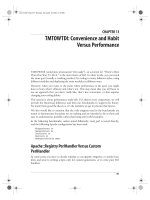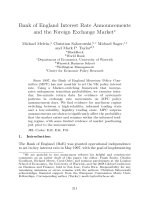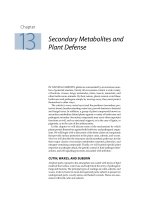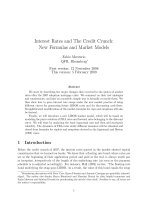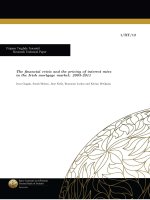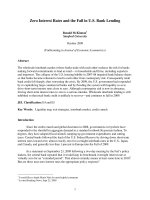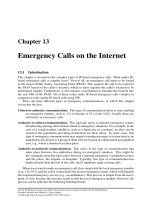Chapter 13 Exchange Rates and the Foreign Exchange Market: An Asset Approach
Bạn đang xem bản rút gọn của tài liệu. Xem và tải ngay bản đầy đủ của tài liệu tại đây (1.34 MB, 48 trang )
Chapter 13
Exchange Rates
and the Foreign
Exchange
Market: An Asset
Approach
Slides prepared by Thomas Bishop
Preview
• The basics of exchange rates
• Exchange rates and the prices of goods
• The foreign exchange markets
• The demand for currency and other assets
• A model of foreign exchange markets
role of interest rates on currency deposits
role of expectations about the exchange rates
Copyright © 2006 Pearson Addison-Wesley. All rights reserved.
13-2
Definitions of Exchange Rates
• Exchange rates are quoted as foreign currency per
unit of domestic currency or domestic currency per
unit of foreign currency.
How much can be exchanged for one dollar? ¥102/$1
How much can be exchanged for one yen? $0.0098/¥1
• Exchange rate allow us to denominate the cost or
price of a good or service in a common currency.
How much does a Honda cost? ¥3,000,000
Or, ¥3,000,000 x $0.0098/¥1 = $29,400
Copyright © 2006 Pearson Addison-Wesley. All rights reserved.
13-3
Depreciation and Appreciation
• Depreciation is a decrease in the value of a
currency relative to another currency.
A depreciated currency is less valuable (less
expensive) and therefore can be exchanged for
(can buy) a smaller amount of foreign currency.
$1/€1 ! $1.20/€1 means that the dollar has
depreciated relative to the euro. It now takes $1.20
to buy one euro, so that the dollar is less valuable.
The euro has appreciated relative to the dollar:
it is now more valuable.
Copyright © 2006 Pearson Addison-Wesley. All rights reserved.
13-4
Depreciation and Appreciation (cont.)
• Appreciation is an increase in the value of a
currency relative to another currency.
An appreciated currency is more valuable (more
expensive) and therefore can be exchanged for
(can buy) a larger amount of foreign currency.
$1/€1 ! $0.90/€1 means that the dollar has
appreciated relative to the euro. It now takes
only $0.90 to buy one euro, so that the dollar is
more valuable.
The euro has depreciated relative to the dollar:
it is now less valuable.
Copyright © 2006 Pearson Addison-Wesley. All rights reserved.
13-5
Depreciation and Appreciation (cont.)
• A depreciated currency is less valuable, and therefore
it can buy fewer foreign produced goods that are
denominated in foreign currency.
How much does a Honda cost? ¥3,000,000
¥3,000,000 x $0.0098/¥1 = $29,400
¥3,000,000 x $0.0100/¥1 = $30,000
• A depreciated currency means that imports are more
expensive and domestically produced goods and
exports are less expensive.
• A depreciated currency lowers the price of exports
relative to the price of imports.
Copyright © 2006 Pearson Addison-Wesley. All rights reserved.
13-6
Depreciation and Appreciation (cont.)
• An appreciated currency is more valuable, and
therefore it can buy more foreign produced goods that
are denominated in foreign currency.
How much does a Honda cost? ¥3,000,000
¥3,000,000 x $0.0098/¥1 = $29,400
¥3,000,000 x $0.0090/¥1 = $27,000
• An appreciated currency means that imports are less
expensive and domestically produced goods and
exports are more expensive.
• An appreciated currency raises the price of exports
relative to the price of imports.
Copyright © 2006 Pearson Addison-Wesley. All rights reserved.
13-7
The Foreign Exchange Market
The participants:
1. Commercial banks and other depository institutions:
transactions involve buying/selling of bank deposits
in different currencies for investment.
2. Non bank financial institutions (pension funds,
insurance funds) may buy/sell foreign assets.
3. Private firms: conduct foreign currency transactions
to buy/sell goods, assets or services.
4. Central banks: conduct official international
reserves transactions.
Copyright © 2006 Pearson Addison-Wesley. All rights reserved.
13-8
The Foreign Exchange Market (cont.)
• Buying and selling in the foreign exchange
market are dominated by commercial banks.
Inter-bank transactions of deposits in foreign
currencies occur in amounts $1 million or more
per transaction.
Central banks sometimes intervene, but the direct
effects of their transactions are usually small
and transitory.
Copyright © 2006 Pearson Addison-Wesley. All rights reserved.
13-9
The Foreign Exchange Market (cont.)
Characteristics of the market:
• Trading occurs mostly in major financial
cities: London, New York, Tokyo, Frankfurt,
Singapore.
• The volume of foreign exchange has grown:
in 1989 the daily volume of trading was $600 billion,
in 2001 the daily volume of trading was $1.2 trillion.
• About 90% of transactions in 2001 involved US
dollars.
Copyright © 2006 Pearson Addison-Wesley. All rights reserved.
13-10
The Foreign Exchange Market (cont.)
• Computers transmit information rapidly and
have integrated markets.
• The integration of markets implies that there is
no significant arbitrage between markets.
if dollars are cheaper in New York than in London,
people will buy them in New York and stop buying
them in London. The price of dollars in New York
rises and the price of dollars in London falls, until
the prices in the two markets are equal.
Copyright © 2006 Pearson Addison-Wesley. All rights reserved.
13-11
Spot Rates and Forward Rates
• Spot rates are exchange rates for currency
exchanges “on the spot”, or when trading is
executed in the present.
• Forward rates are exchange rates for
currency exchanges that will occur at a future
(“forward”) date.
forward dates are typically 30, 90, 180 or 360 days
in the future.
rates are negotiated between individual institutions
in the present, but the exchange occurs in the
future.
Copyright © 2006 Pearson Addison-Wesley. All rights reserved.
13-12
Spot and Forward Rates
Copyright © 2006 Pearson Addison-Wesley. All rights reserved.
13-13
Other methods of currency exchange
• Foreign exchange swaps: a combination of a spot
sale with a forward repurchase, both negotiated
between individual institutions.
swaps often result in lower fees or transactions costs
because they combine two transactions.
• Futures contracts: a contract designed by a third
party for a standard amount of foreign currency
delivered/received on a standard date.
contracts can be bought and sold in markets, and only the
current owner is obliged to fulfill the contract.
Copyright © 2006 Pearson Addison-Wesley. All rights reserved.
13-14
Other Methods of Currency Exchange
• Options contracts: a contract designed by a
third party for a standard amount of foreign
currency delivered/received on or before a
standard date.
contracts can be bought and sold in markets.
a contract gives the owner the option, but not
obligation, of buying or selling currency if the
need arises.
Copyright © 2006 Pearson Addison-Wesley. All rights reserved.
13-15
The Demand for Currency Deposits
• What influences the demand for (willingness
to buy) deposits denominated in domestic or
foreign currency?
• Factors that influence the return on assets
determine the demand for those assets.
Copyright © 2006 Pearson Addison-Wesley. All rights reserved.
13-16
The Demand for Currency Deposits (cont.)
• Rate of return: the percentage change in value that
an asset offers during a time period.
The annual return for $100 savings account with an interest
rate of 2% is $100 x 1.02 = $102, so that the rate of return =
($102 - $100)/$100 = 2%
• Real rate of return: inflation-adjusted rate of return.
stated in terms of real purchasing power: the amount of real
goods & services that can be purchased with the asset.
the real rate of return for the above savings account when
inflation is 1.5%: 2% – 1.5% = 0.5%. The asset can
purchase 0.5% more goods and services after 1 year.
Copyright © 2006 Pearson Addison-Wesley. All rights reserved.
13-17
The Demand for Currency Deposits (cont.)
• If prices are given at some level, inflation is
0% and (nominal) rates of return = real rates
of return.
• For bank deposits in different currencies, we
often assume that prices are given at some
level. (A good short run assumption.)
Copyright © 2006 Pearson Addison-Wesley. All rights reserved.
13-18
The Demand for Currency Deposits (cont.)
• Risk of holding assets also influences decisions
about whether to buy them.
• Liquidity of an asset, or ease of using the asset to
buy goods and services, also influences the
willingness to buy assets.
• But we assume that risk and liquidity of bank
deposits in the foreign exchange market are the
same, regardless of their currency denomination.
risk and liquidity are only of secondary importance when
deciding to buy or sell currency.
importers and exporters may be concerned about risk and
liquidity, but they make up a small fraction of the market.
Copyright © 2006 Pearson Addison-Wesley. All rights reserved.
13-19
The Demand for Currency Deposits (cont.)
• We assume that investors are primarily
concerned about the rates of return on bank
deposits. Rates of return are determined by
interest rates that the assets earn
expectations about appreciation or depreciation
Copyright © 2006 Pearson Addison-Wesley. All rights reserved.
13-20
The Demand for Currency Deposits (cont.)
• A currency’s interest rate is the amount of a currency
an individual can earn by lending a unit of the
currency for a year.
• The rate of return for a deposit in domestic currency
is the interest rate that the bank deposit earns.
• To compare the rate of return on a deposit in
domestic currency with one in foreign currency,
consider
the interest rate for the foreign currency deposit
the expected rate of appreciation or depreciation of the
foreign currency relative to the domestic currency.
Copyright © 2006 Pearson Addison-Wesley. All rights reserved.
13-21
The Demand for Currency Deposits (cont.)
• Suppose the interest rate on a dollar deposit is 2%.
• Suppose the interest rate on a euro deposit is 4%.
• Does a euro deposit yield a higher expected rate
of return?
Suppose today the exchange rate is $1/€1, and the expected
rate 1 year in the future is $0.97/€1.
$100 can be exchanged today for €100.
These €100 will yield €104 after 1 year.
These €104 are expected to be worth $0.97/€1 x €104 =
$100.88.
Copyright © 2006 Pearson Addison-Wesley. All rights reserved.
13-22
The Demand for Currency Deposits (cont.)
• The rate of return in terms of dollars from investing in
euro deposits is ($100.88-$100)/$100 = 0.88%.
• Let’s compare this rate of return with the rate of return
from a dollar deposit.
rate of return is simply the interest rate
After 1 year the $100 is expected to yield $102:
($102-$100)/$100 = 2%
• The euro deposit has a lower expected rate of return:
all investors will prefer dollar deposits and none are
willing to hold euro deposits.
Copyright © 2006 Pearson Addison-Wesley. All rights reserved.
13-23
The Demand for Currency Deposits (cont.)
• Note that the expected rate of appreciation of
the euro is ($0.97- $1)/$1 = -0.03 = -3%.
• We simplify the analysis by saying that the
dollar rate of return on euro deposits
approximately equals
the interest rate on euro deposits
plus the expected rate of appreciation on
euro deposits
4% + -3% = 1% ≈ 0.88%
• R€ + (Ee$/€ - E$/€)/E$/€
Copyright © 2006 Pearson Addison-Wesley. All rights reserved.
13-24
The Demand for Currency Deposits (cont.)
• The difference in the rate of return on dollar
deposits and euro deposits is
• R$ - (R€ + (Ee$/€ - E$/€)/E$/€ ) =
R$
expected rate
of return =
interest rate
on dollar
deposits
- R€
interest rate
on euro
deposits
- (Ee$/€ - E$/€)/E$/€
expected
exchange rate
current
exchange rate
expected rate of appreciation
of the euro
expected rate of return on euro deposits
Copyright © 2006 Pearson Addison-Wesley. All rights reserved.
13-25
